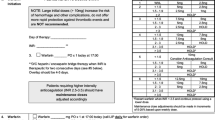Abstract
Warfarin is one of the most commonly used medications associated with adverse events. Warfarin therapy is often initiated or continued in the hospital, yet hospitalization increases the risk of poor anticoagulation control with warfarin. To help understand this, we retrospectively reviewed the records of patients admitted to our hospital during a 6-month period who were given at least one dose of warfarin. To explore factors that may have contributed to poor anticoagulation control, we compared characteristics of patients with an international normalized ratio (INR) ≥5 at some point during hospitalization with those of a group of matched controls who also received warfarin and had INR <5. Among the 35 patients identified who had an INR ≥5, concomitant use of antibiotics was more common than among 105 matched controls; improper warfarin dosing also appeared to contribute to the high INRs. These findings indicate possible targets for intervention to improve patient safety.
Similar content being viewed by others
Abbreviations
- CI:
-
Confidence interval
- INR:
-
International normalized ratio
- OR:
-
Odds ratio
References
Hirsh J, Guyatt G, Albers GW, Harrington R, Schunemann HJ, American College of Chest Physicians (2008) Executive summary: American College of Chest Physicians evidence-based clinical practice guidelines, 8th edn. Chest 133(6 Suppl):71S–109S. Erratum in: Chest 134(4):892
Higashi MK, Veenstra DL, Kondo LM, Wittkowsky AK, Srinouanprachanh SL, Farin FM et al (2002) Association between CYP2C9 genetic variants and anticoagulation-related outcomes during warfarin therapy. JAMA 287(13):1690–1698
van Walraven C, Austin PC, Oake N, Wells P, Mamdani M, Forster AJ (2007) The effect of hospitalization on oral anticoagulation control: a population-based study. Thromb Res 119(6):705–714
Palareti G, Leali N, Coccheri S, Poggi M, Manotti C, D’Angelo A et al (1996) Bleeding complications of oral anticoagulant treatment: an inception-cohort, prospective collaborative study (ISCOAT): Italian Study on Complications of Oral Anticoagulant Therapy. Lancet 348(9025):423–428
National Patient Safety Goals (2008) Oakbrook terrace (IL): The Joint Commission. c2008. http://www.jointcommission.org/PatientSafety/NationalPatientSafetyGoals. Accessed Dec 10, 2007
Glasheen JJ, Fugit RV, Prochazka AV (2005) The risk of overanticoagulation with antibiotic use in outpatients on stable warfarin regimens. J Gen Intern Med 20(7):653–656
Quiroz R, Gerhard-Herman M, Kosowsky JM, DeSantis SM, Kucher N, McKean SC et al (2006) Comparison of a single end point to determine optimal initial warfarin dosing (5 mg versus 10 mg) for venous thromboembolism. Am J Cardiol 98(4):535–537
Kovacs MJ, Rodger M, Anderson DR, Morrow B, Kells G, Kovacs J et al (2003) Comparison of 10-mg and 5-mg warfarin initiation nomograms together with low-molecular-weight heparin for outpatient treatment of acute venous thromboembolism: a randomized, double-blind, controlled trial. Ann Intern Med 138(9):714–719
Crowther MA, Ginsberg JB, Kearon C, Harrison L, Johnson J, Massicotte MP et al (1999) A randomized trial comparing 5-mg and 10-mg warfarin loading doses. Arch Intern Med 159(1):46–48
Harrison L, Johnston M, Massicotte MP, Crowther M, Moffat K, Hirsh J (1997) Comparison of 5-mg and 10-mg loading doses in initiation of warfarin therapy. Ann Intern Med 126(2):133–136
Eckhoff CD, Didomenico RJ, Shapiro NL (2004) Initiating warfarin therapy: 5 mg versus 10 mg. Ann Pharmacother 38(12):2115–2121
Bond CA, Raehl CL (2004) Pharmacist-provided anticoagulation management in United States hospitals: death rates, length of stay, Medicare charges, bleeding complications, and transfusions. Pharmacotherapy 24(8):953–963
Dager WE, Branch JM, King JH, White RH, Quan RS, Musallam NA et al (2000) Optimization of inpatient warfarin therapy: impact of daily consultation by a pharmacist-managed anticoagulation service. Ann Pharmacother 34(5):567–572
Conflicts of interest
The authors have no conflicts of interest to disclose.
Author information
Authors and Affiliations
Corresponding author
Rights and permissions
About this article
Cite this article
Dawson, N.L., Klipa, D., O’Brien, A.K. et al. Oral anticoagulation in the hospital: analysis of patients at risk. J Thromb Thrombolysis 31, 22–26 (2011). https://doi.org/10.1007/s11239-010-0473-5
Published:
Issue Date:
DOI: https://doi.org/10.1007/s11239-010-0473-5




